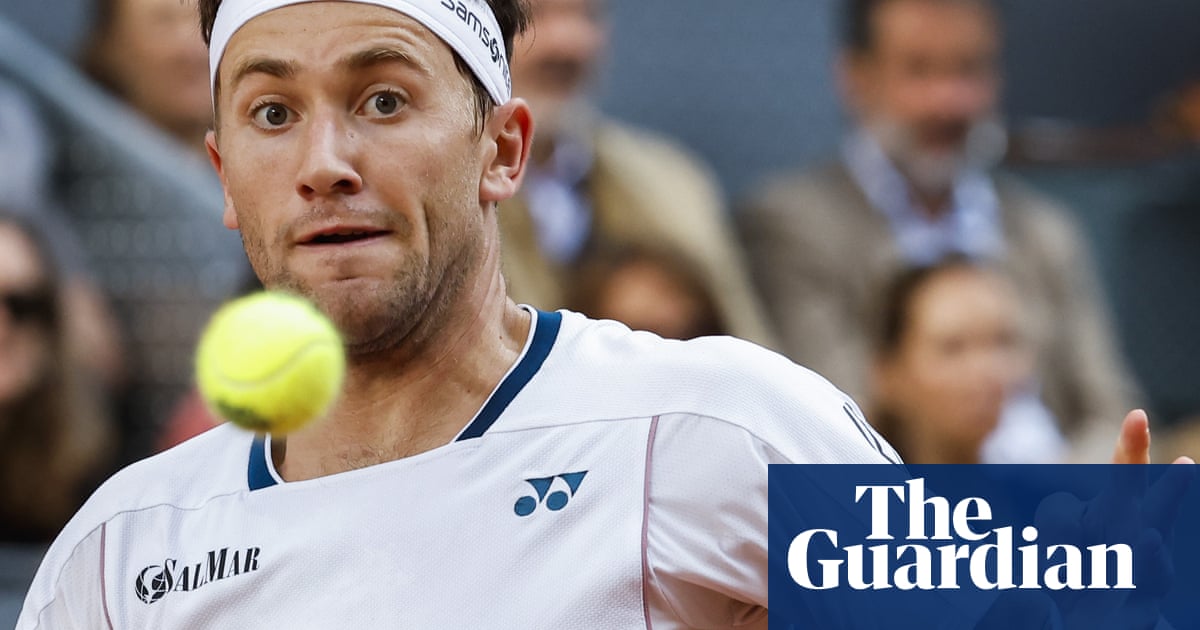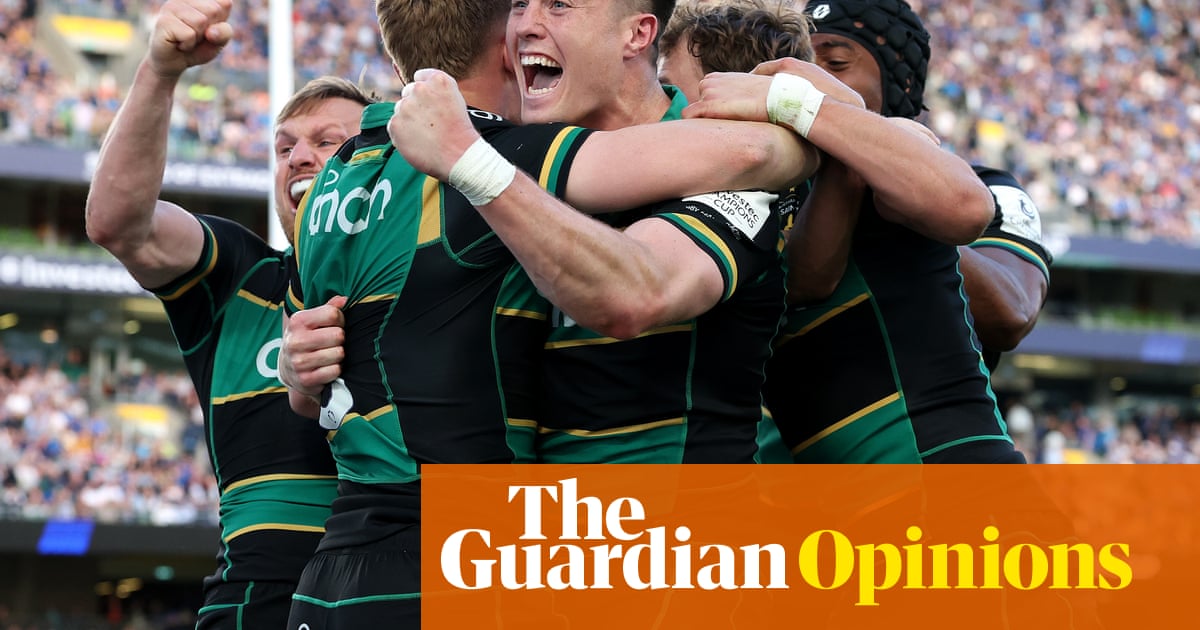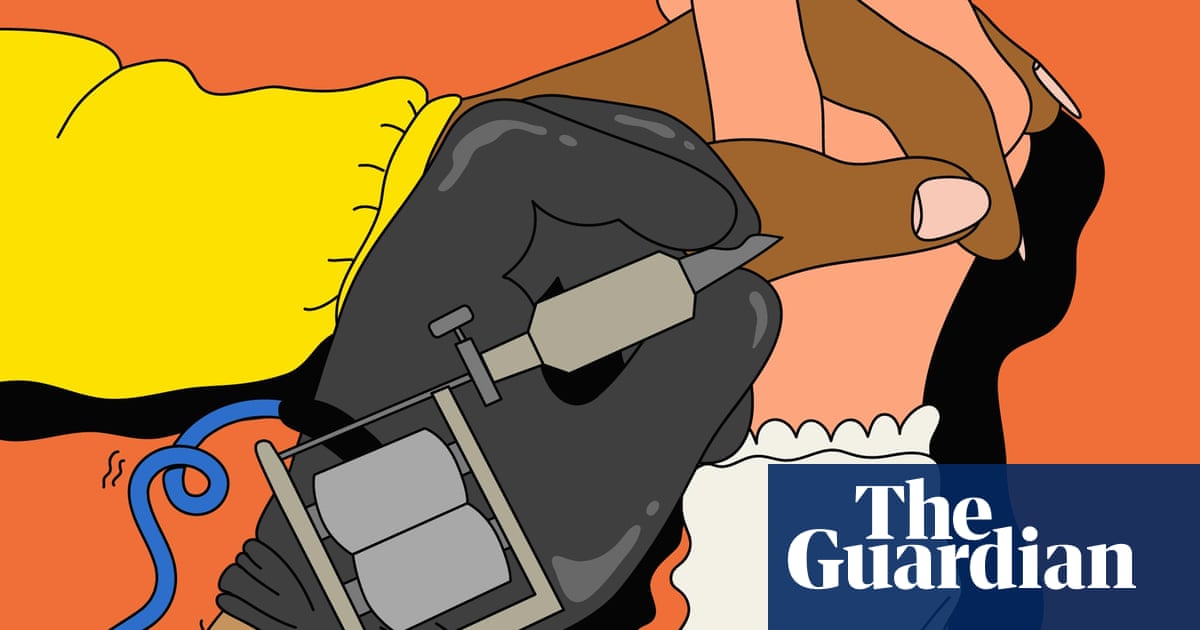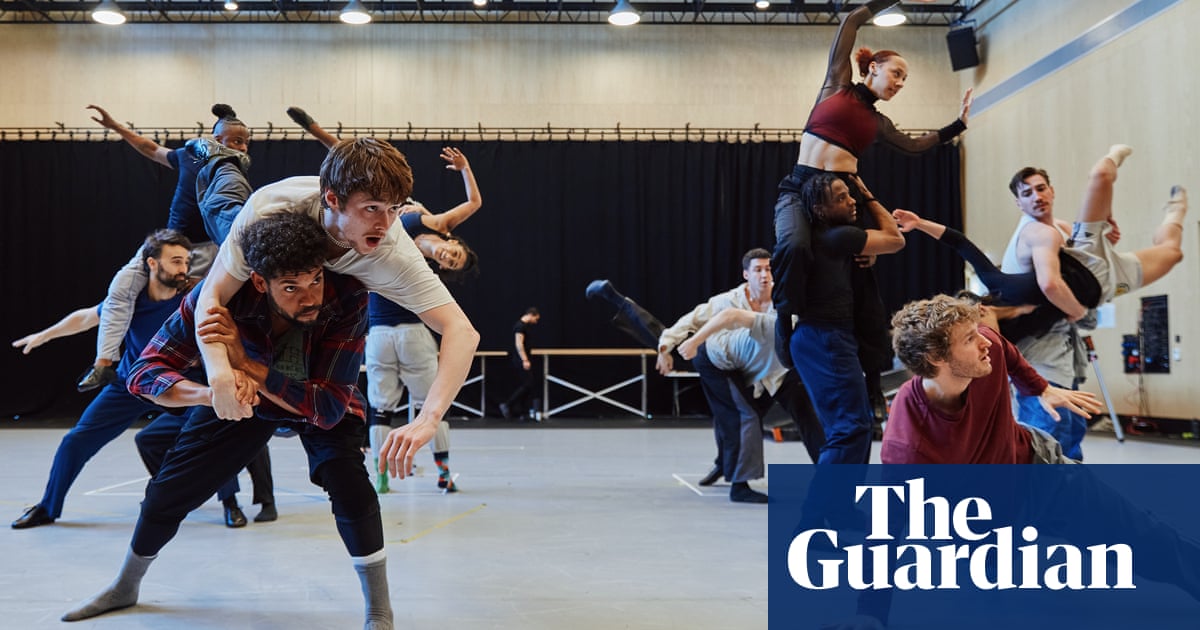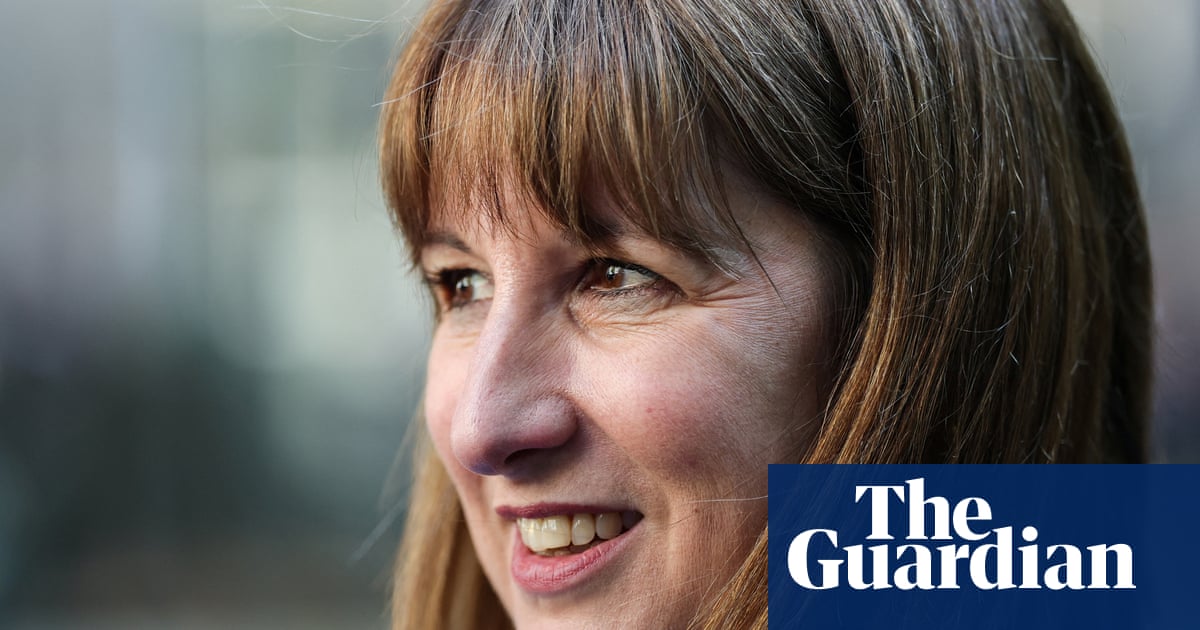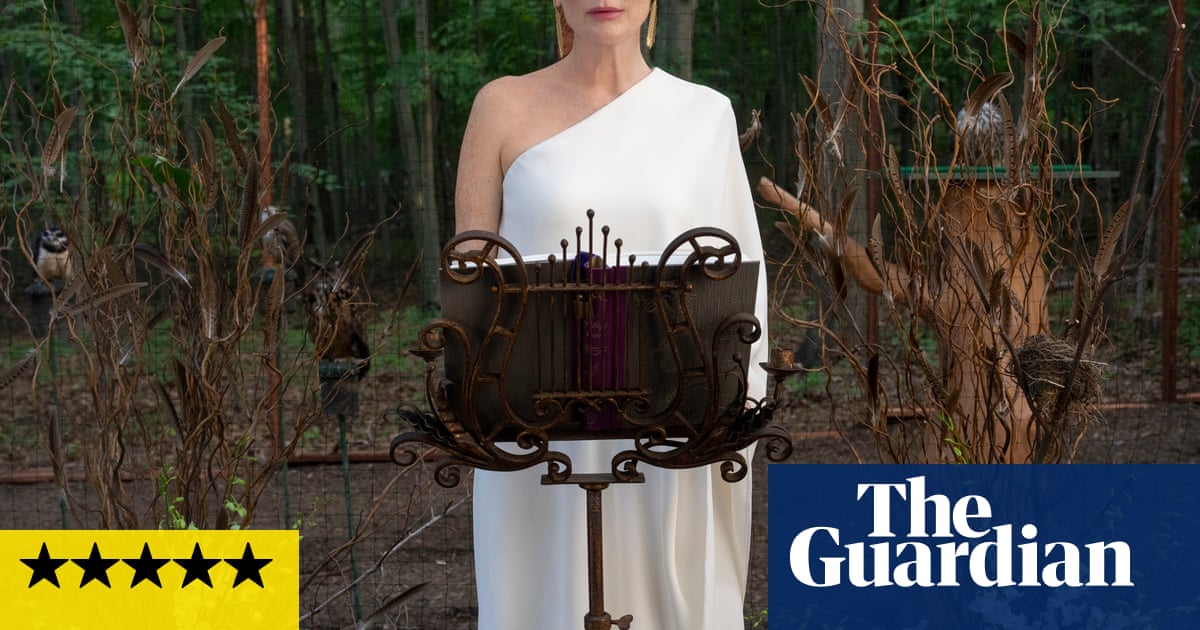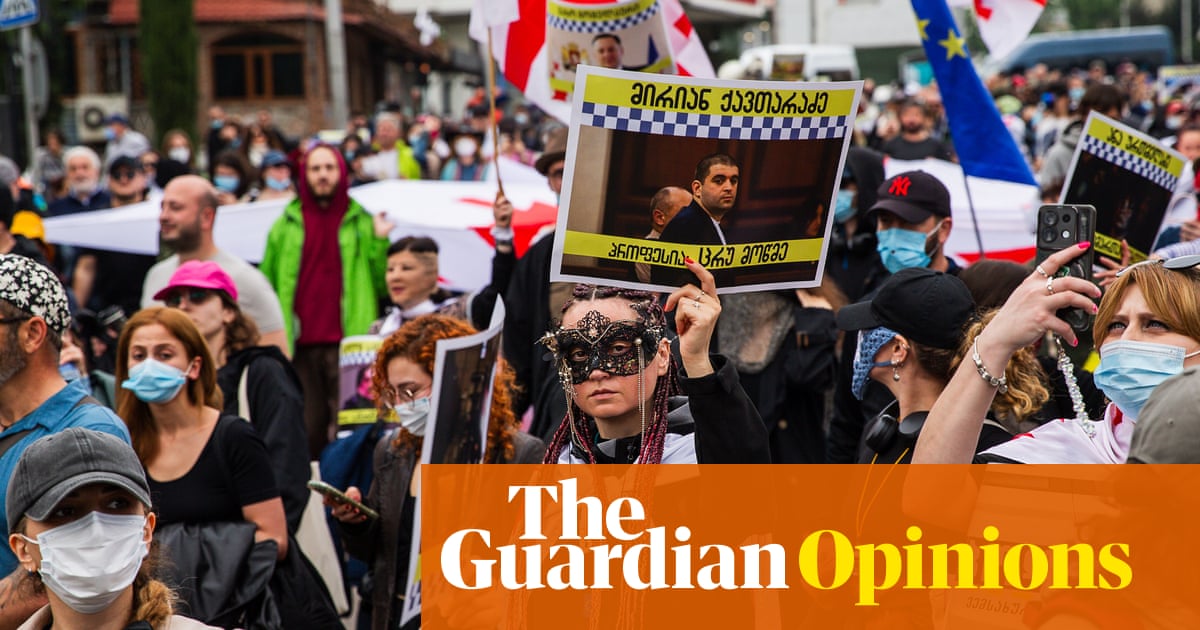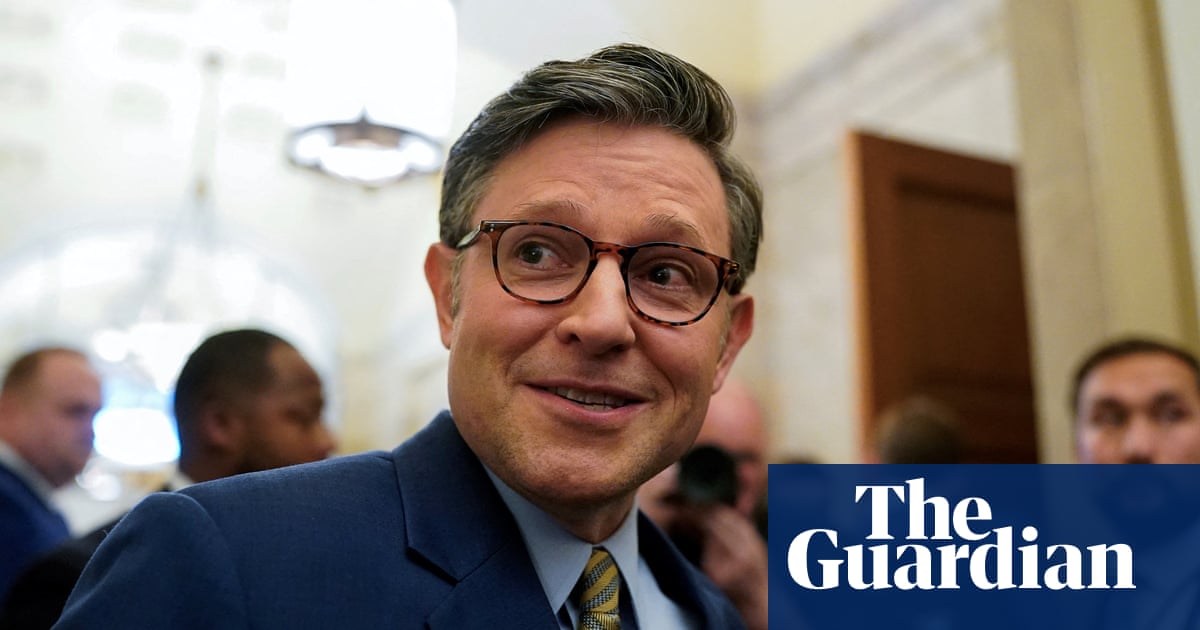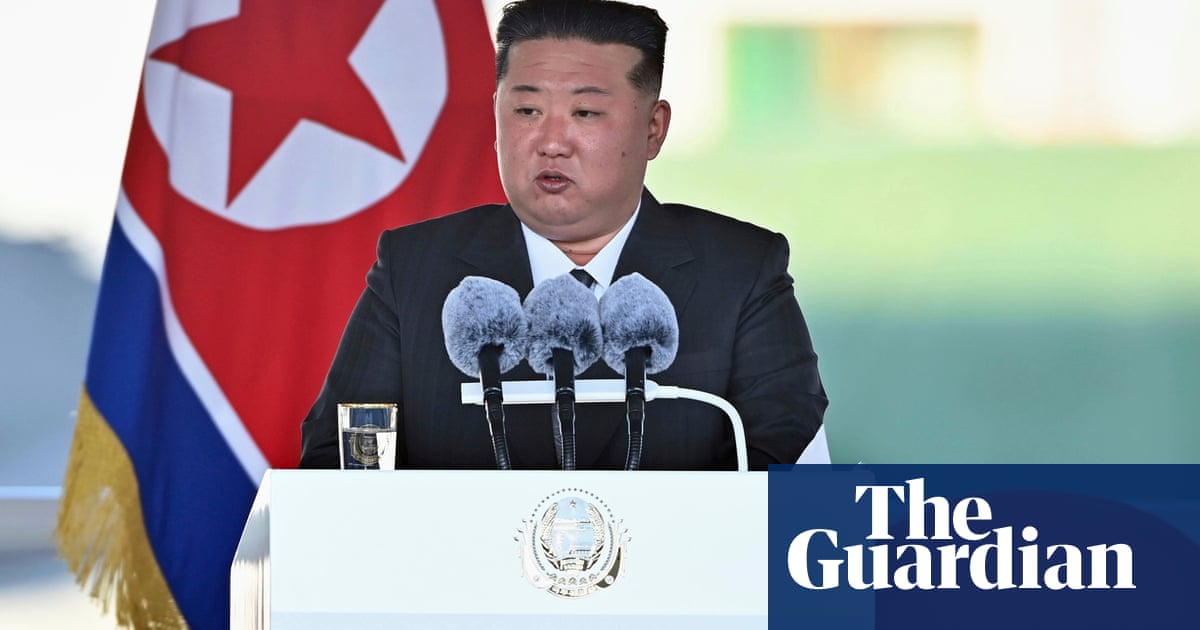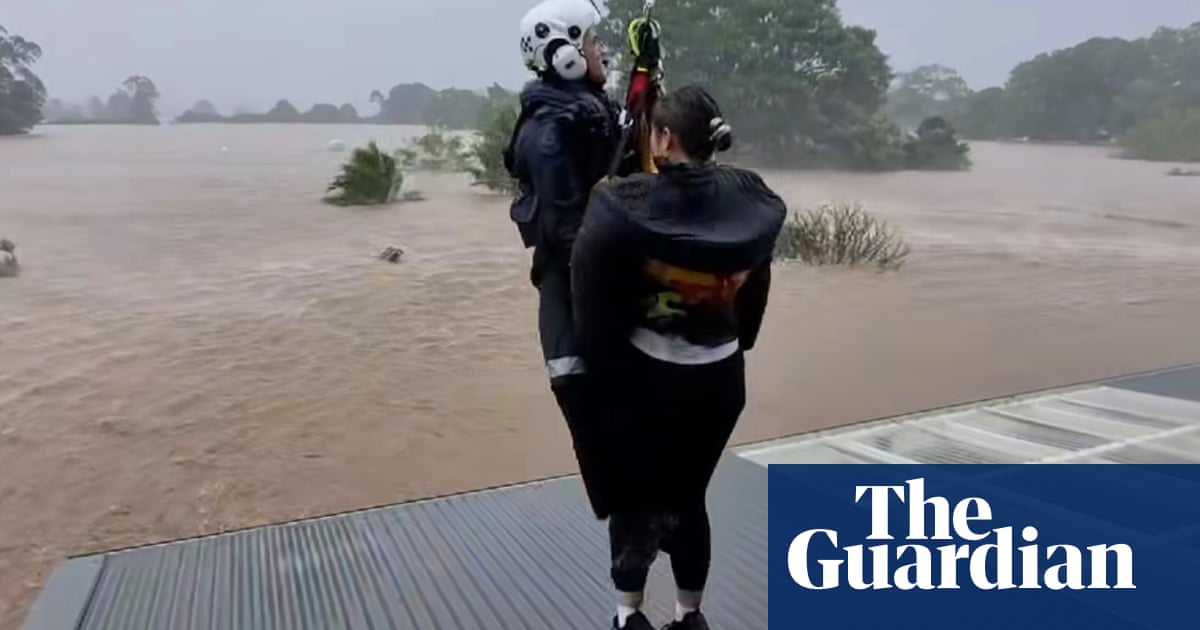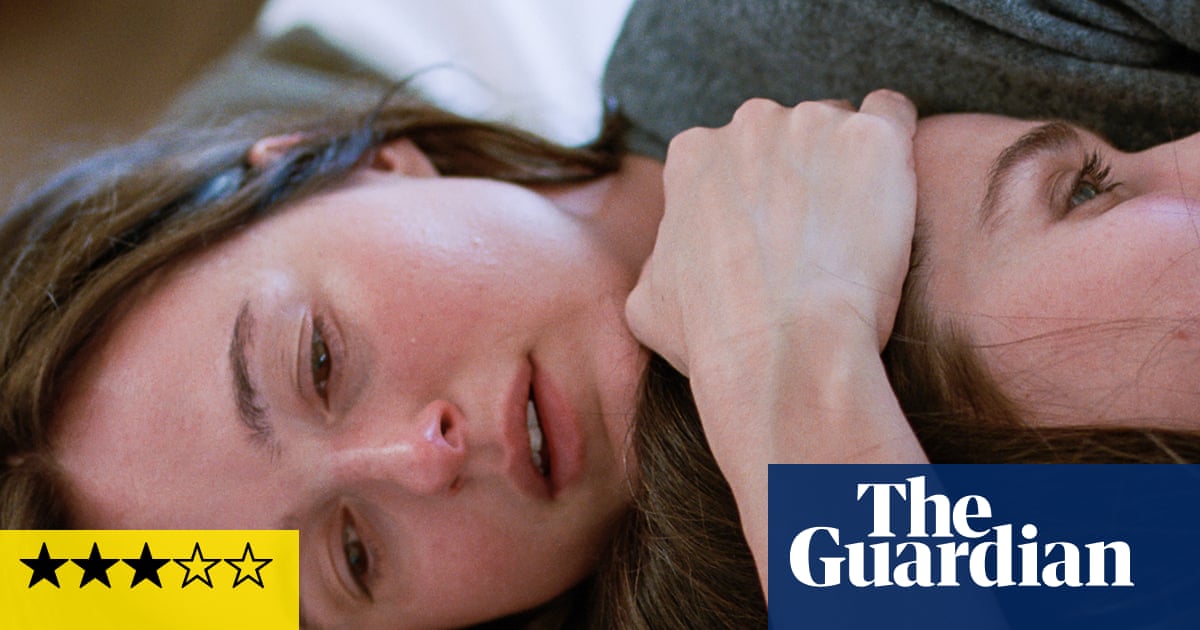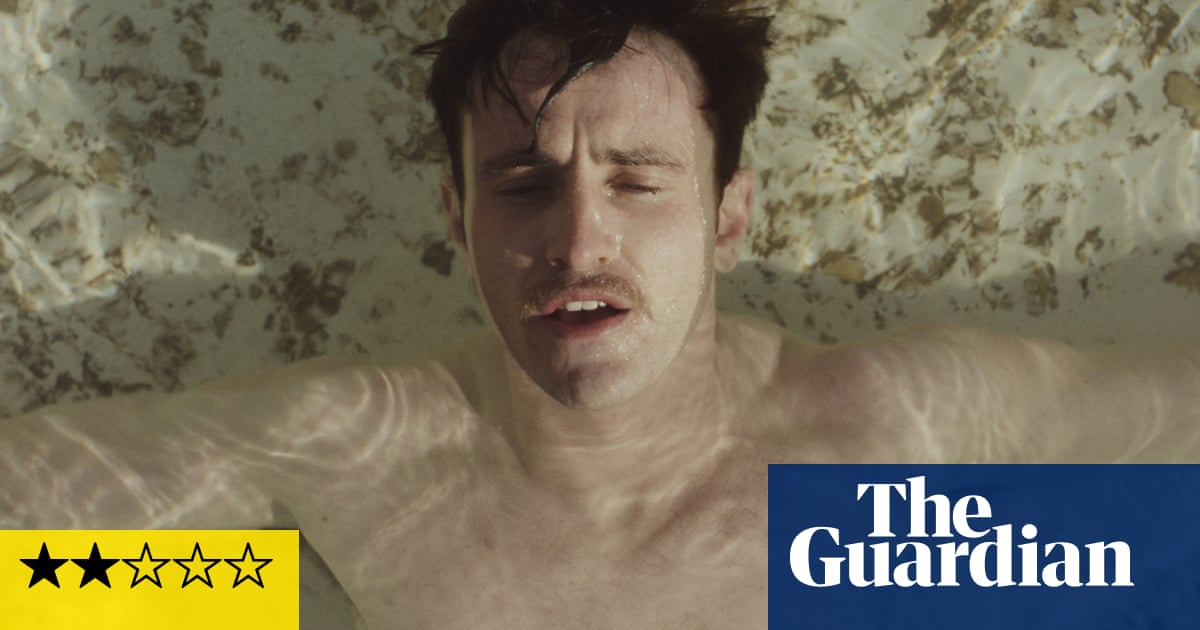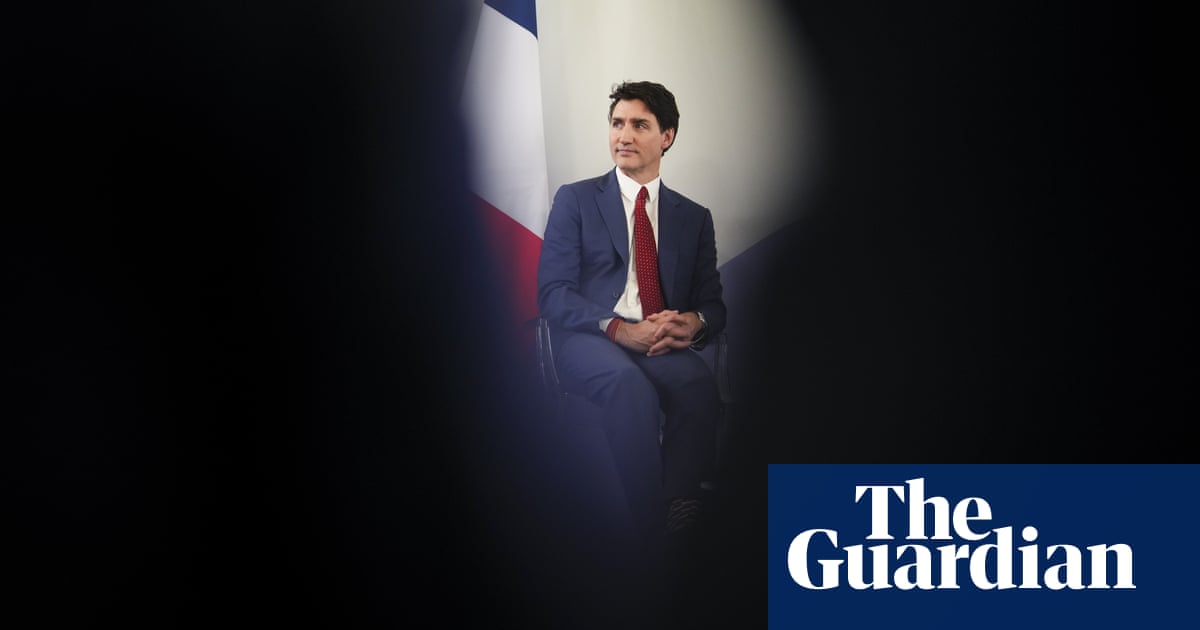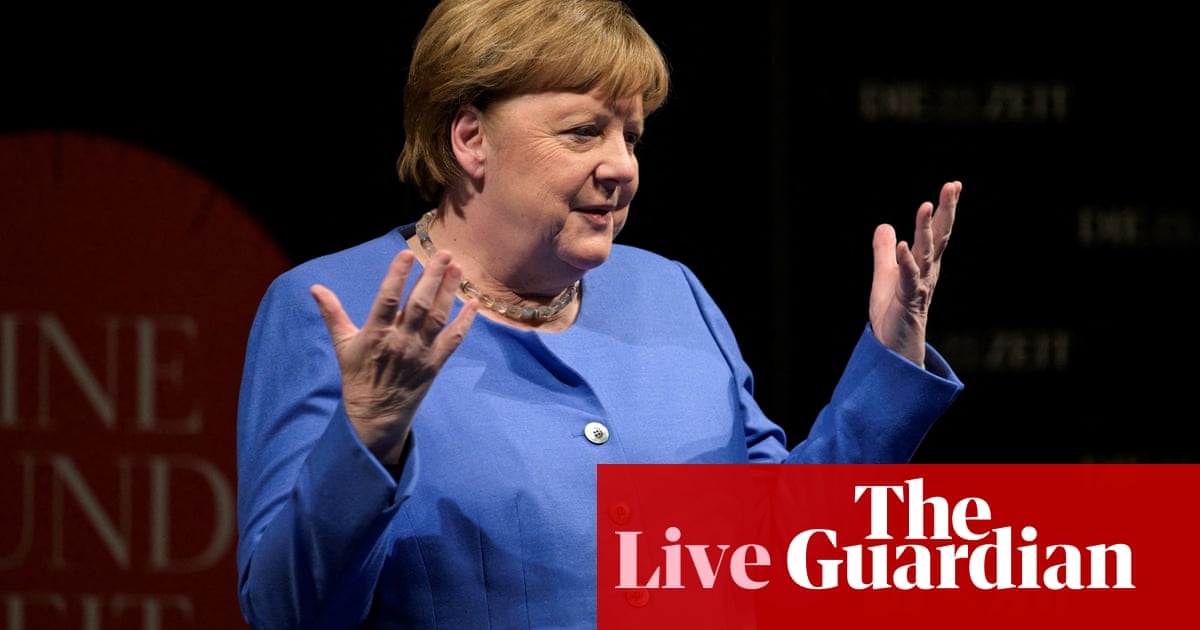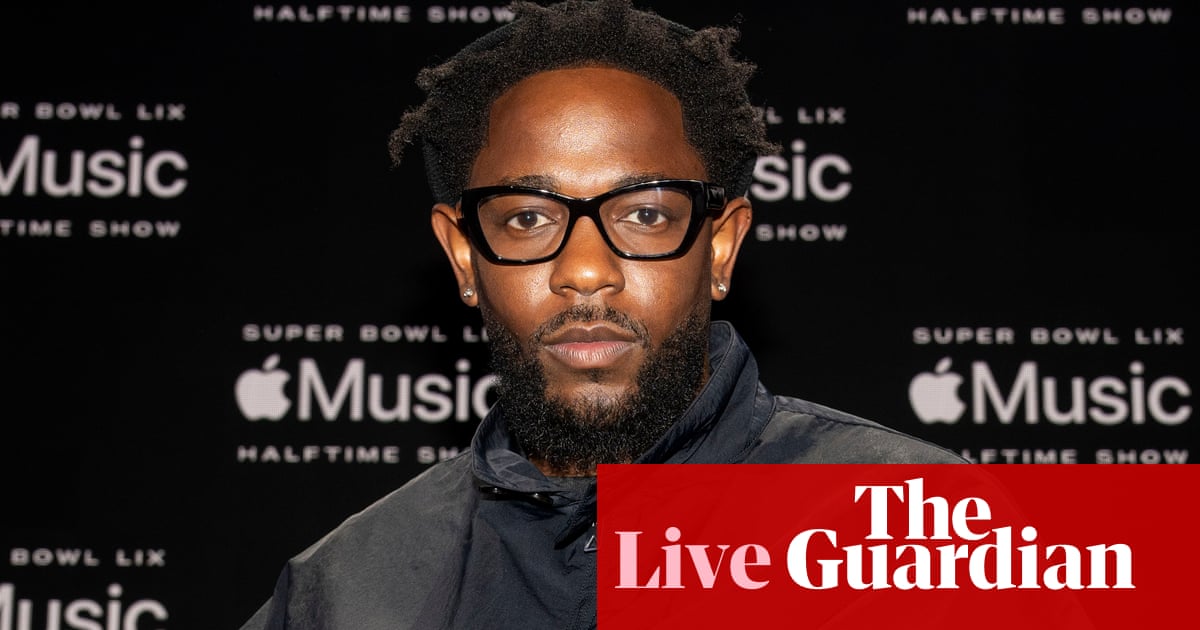.gif?width=445&dpr=1&s=none&crop=none)
Jamie Carragher’s legs were aching. He had been speaking to a Sky Sports cameraman for 25 minutes. Usually for a news interview it’s just 10, but today called for something more. Reports were coming out that Trent Alexander-Arnold, who inherited Carragher’s mantle as the local mainstay of Liverpool’s defence, was about to announce his long-expected departure from his boyhood club, and so, as sure as day follows night, a camera crew had been hastily dispatched to Carragher’s whereabouts to find a quiet spot, hit record and get his opinions out to viewers before they’d had a chance to fully form their own.
How much was there to say about a subject that had already been talked about all season long? Quite a lot, it turned out. Like a hunter-gatherer extracting a week’s worth of food from a seemingly arid wilderness, Carragher – occasionally prompted by a Sky Sports anchor in the studio – launched into nearly half an hour of pure, free-flowing, agenda-setting football opinionating. From this monologue, Sky would carve out a TV report, YouTube interview, news article and three short-form videos. When Carragher says something – about Alexander-Arnold’s future, Arsenal’s attack, Chelsea’s owners or Fifa’s executives – we tend to hear about it very shortly after.
The spot they’d chosen for the interview was, in fact, the first place that Carragher ever kicked a ball, 44 years ago – an indoor pitch that, on the day of filming, was also hosting a group of retirees playing boules just out of shot. We were in the Brunswick, a community centre just off Marsh Lane in the redbrick Merseyside docklands of Bootle. This is the centre of Carragher’s universe. All the places that formed him can be found within a half-mile radius: his childhood home, his dad’s pub, his old school, his church, his in-laws’ home, his favourite chip shop.
Carragher is, with the exception of Sir Paul McCartney, the world’s most famous scouser. It’s true there are other contenders – Mel C, Wayne Rooney, Stephen Graham – but no one else is so internationally known as a scouser. For the past 30 years, through his 737 appearances for Liverpool and thousands of hours of media appearances, Carragher has been the embodiment of how the city likes to see itself: chippy, loquacious, witty, incorrigibly argumentative, perennially spoiling for some kind of fight and confident of winning it. He is a composite of so many quintessentially scouse details: Irish surname, Catholic mother, publican father, married to his childhood sweetheart, living close to where he grew up (although he did trade Bootle for verdant Blundellsands, a plush suburb beloved by footballers). His accent is the benchmark, the go-to when someone tries out an “Eeeerm” or an “Arrite ther”. He is so scouse that he avoids using a wallet, having been mocked by his friends for once doing so in his early 20s. Wallet use is, in some quarters of the city, seen as a transgression upon one’s scouseness; to have so many cards and coins to organise is to be acting above your station, or “wool behaviour” as it’s known internally. (A wool, or woolyback, is a historic, derogatory way of referring to non-Liverpudlians travelling in to the city from Cheshire or the Wirral.)
Once an unglamorous utility player for a faded giant struggling to recapture its old form, Carragher now leads his more decorated peers in the art of talking about football. Since joining Sky Sports in 2013, to front its flagship analysis show, Monday Night Football, Carragher, and his old rival turned co-host, Gary Neville, have led a shift in the way the sport is discussed. They pioneered a style that embraced graphs and data points when “statistics” was still treated like a dirty word. They revelled in the detail of systems, shapes and formations, and offered insights that went into players’ minds and managers’ offices.
With Neville stepping back last August, Monday Night Football has completed its years-long transition to becoming the Jamie Carragher show. Factor in the ceaseless stream of Carragher content – co-commentary on Sky’s Super Sunday games, regular interviews for Sky Sports News, guest spots on Neville’s spin-off podcasts, his pivotal role in Champions League coverage for CBS Sports – and sometimes it seems the sport itself is heading that way, too. Able to channel his old-school football education, steeped in the tough-tackling, baggy-shirted Barclays of yore, with cutting edge insights and a knack for creating highly meme-able moments, he has become the face – and unlikely voice – of modern football punditry.
Over the past decade or so, technology has transformed the experience of football. The days of checking the scores the next morning in the newspaper are, of course, long gone, but even watching the match and the post-match analysis feel like only a small slice of what football has become. Regrettably, from the point of view of the attention economy, a match only lasts 90 minutes – a pitifully small slice of the day. And so a whole universe of content – podcasts, TikTok and YouTube videos, Instagram reels, clips shared on X – has sprung up to fill the remaining minutes when football is not occurring. Sometimes, it can feel like football matches are played merely in order to provide the content for this great discourse machine.
In this new world, every flavour of fandom is catered for. “There’s a whole host of people that want smarter, knowledgable commentary,” says Ted Knutson, the founder of the sports data firm Statsbomb. He pointed to the millions of Fantasy Premier League players seeking the latest data to stay ahead of their transfers. “They’re not a little subsection – that’s a lot of people who want better analysis.” On the other hand, there is the ever-more streamlined production line of hot takes, powered by pundits who are also full-time social media personalities. “You know,” Knutson bemoans, “where somebody says something big, and then we argue about it for a 48-hour media cycle, and then we recycle it with some other dumb take. It’s a very US-style approach.” Nobody, least of all Knutson, would accuse Carragher of being above this manner of punditry. “His job is his job,” he says, “Let’s not pretend that it’s not a volume-based industry.” But there is far more to Carragher than this.
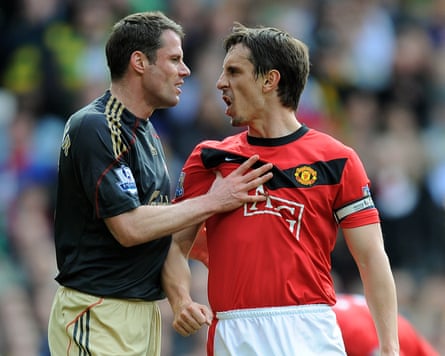
The market for football punditry now demands a vast, almost contradictory, range of styles – from cool analysis to partisan rage, serious inquiry to breezy diversion – yet Carragher is fluent in virtually all of them. As a generator of football content, he is unmatched. Each of his monologues can be spun off, by Sky Sports and increasingly others, into five or six different stories, from TikTok ragebait to measured analysis to 00s nostalgia – something for everyone, whether you like Carragher or not. If you’re not a fan of his, you are not alone, and Carragher is relaxed about it. He annoys his fellow Liverpool supporters by giving the club too hard a time; he annoys other fans who think he gives Liverpool too easy a ride. There are Evertonians who’ve never forgiven him for switching his allegiance to the red half of Liverpool, and Kopites who think he’s gone a little too showbiz since retirement. Erling Haaland, Mo Salah and Cristiano Ronaldo have all reacted negatively to his feedback, with Ronaldo once blanking him live on-air. All this, of course, makes for good numbers. “I’ve never met somebody as wholly unbothered by what people say about him on social media as Jamie is,” says Kate Scott, who presents CBS Sports’ Champions League coverage with Carragher. “He’s the king of understanding what will do well on socials, but he doesn’t allow it to move him.”
Having finished filming, Carragher headed back through the foyer to one of the community centre’s classrooms, where he enjoyed a mug of soup made from vegetables grown in its garden, and then set about signing a stack of shirts and shoeboxes. Most Thursday afternoons, you will find Carragher here, working through a pile of merchandise with a Sharpie, effectively minting his own currency for local charities, hospitals and community groups to fundraise with. After that, he’ll say hello to the centre’s members, which means anyone who pays the £1 entry fee: veterans, pensioners, kids on half-term. If a game of football breaks out on the indoor pitch, he’s easily coaxed back inside to play centre-half.
For years, it felt as if Carragher belonged exclusively to Liverpool, but his modern fame outstrips that of his playing days many times over. “I get stopped more now than I ever did as a player,” he told me. He can’t go two minutes in public without a honking car horn and a roar of “Carrraaaa!” dopplering past. He waves back with Pavlovian consistency.
“Punditry used to feel like an add-on to the game,” Carragher mused, mopping up the last of his soup with a chunk of white bread. “But it almost feels like a game in itself these days. Are we storytellers? Are we characters? Are we both?”
Monday Night Football begins, like so much else in the world, as an empty Google doc at the start of the working week. On one such mid-December Monday, I sat with the show’s production team in a glass meeting room on the fourth floor of the Keith Rupert Murdoch Building, the heart of the sprawling Sky Campus on the outer fringes of west London, as they began to turn the weekend’s WhatsApp messages into something approximating an agenda.
Sweeping in at 10am, flanked by two video analysts and snacking from a punnet of impossibly tiny grapes, came Carragher. As always, he had spent the weekend obsessively watching every match he could, dutifully taking notes, before covering a chaotic Sunday afternoon tie between Tottenham and Chelsea, which saw him lambast both sides for defensive disorganisation. “We start every meeting the same way,” Carragher told me later, “It’s always: ‘What’s the story?’ That’s always the big thing: ‘What’s the story?’”
The match they had lined up for this evening was a winter dogfight between West Ham and Wolves. Stats and graphs were shared around to support the narrative that was steadily taking shape in the room – that tonight’s match was the last chance saloon for both sides and their underperforming managers. As they thrashed it all out, David Jones, the show’s presenter, challenged the idea that Julen Lopetegui, West Ham’s coach, was under any great risk. “But he is!” Carragher retorted in an incredulous tone familiar to former teammates and viewers alike. “They’ve just lost back-to-back, how can you say he’s not?” (Lopetegui was fired weeks later.)
Over the course of 90 minutes, the evening’s show came into focus. At one stage, with an astounding casualness – as if it was the natural next step of the conversation – Carragher sprang to his feet and, with the assistance of his two young “clip guys” playing the moments he’d asked for, started dissecting footage in real time, gesturing at a screen to highlight lapsed defensive lines and wasted touches. It was clear when he had been particularly persuasive: the team went quiet, the follow-up questions stopped and producer Jack Hazzard earmarked it for the show.
In its most combative forms, Carragher’s punditry mirrors his playing style: verbal challenges, needly questions, sharp-edged jokes with the pointedness of a toe poke against the shin when the referee’s back is turned. Faced with opposing viewpoints, he piles on the pressure with a barrage of questions: “Why is that? But why is that? How can you think that?” When it comes to making his own points, however, today’s Carragher is more elegant than he ever was on the pitch. What begins as a simple question – ‘Cole Palmer: what are your thoughts?’ – can give rise to a mazy discourse that borders on the free-associative, touching on his own childhood, memories of a young Steven Gerrard, club ownership models, contract law, tactical flexibility, emotional maturity and the relationship between fans and managers, before neatly coming back to earth with a succinct point about Palmer’s eye for a through-ball. And after a decade on the air, he has learned to create as much for colleagues as he does for himself. “He’s always thinking one step ahead,” says Kate Scott, “he sets up the alley-oop for everyone else.”
Today’s lead pundits don’t just arrive, talk football and leave, as ex-pros once did. Nowadays, you have to earn your keep. After lunch, on the day I visited, Carragher and Jones had been corralled into playing themselves for an advertising skit for Sky’s darts coverage. The concept was Monday Night Football – but for darts. A couple of Sky executives, watching from the sidelines, grimaced throughout. “This is crap,” one muttered, with some justification. But with Sky looking to push its darts coverage harder than ever, Carragher’s star power was deemed necessary to the effort.

Promotional considerations taken care of, rehearsals for that night’s show began at 3pm with the arrival of guest host, the former West Ham, Spurs and England striker Jermain Defoe. He was greeted with big hugs and a round of stick from Carragher. “Get on you with the Dior clobber,” Carragher said, beaming. “Your diamond earring there as well, how much was that?” Defoe, though a veteran of the game, is still something of a novice pundit. This would be his Monday Night Football debut. Carragher, making his 184th appearance, coached him through the basics – standing behind Defoe, holding his shoulders, and showing him how to open up his body towards the camera and point toward the screen in a way that makes for good television. “I always describe it like being on a night out,” Carragher told me. “You’ve got so much going on in your head, hand-eye coordination, rhythm, stamina – by the end of the night you’re that wired, you can’t get to sleep.”
On Monday Night Football, Carragher’s presentational tone is vaguely reminiscent of Neil Buchanan, another pioneering scouse educator, in the classic kids’ TV show Art Attack. He keeps his stance low, his sentences clipped and demonstrative as his body draws you to observe a player “there” – pause – “and over hee-yeh, right there”. The giant screen at the heart of the studio immerses Carragher in the passage of play and his body becomes the annotation, as he shuttles around to keep your eyes trained on the moments he’s trying to highlight. “That’s incredibly challenging to do,” says Statsbomb’s Ted Knutson, who has compared Carragher’s presentations to the calibre he’s seen first-hand in Premier League training grounds. “You need to make it really simple, and still have a very high impact.”
How to move is one thing; what to say is another. “Whatever you do, don’t criticise Mo Salah or you’ll have hell to pay,” Carragher told Defoe. He puffed out his cheeks, “Honest to God, my social media.”
About half an hour before the show was to begin, earpieces were fitted, and producer Hazzard’s voice – punctuated by occasional bleeps and cable static – began its weekly transmission directly into the pundit’s heads. Minutes before showtime, as clips were readied and graphics were finalised, the floor manager emerged to handle perhaps the most vital element of the production: what the panellists wanted to order from the Chinese takeaway in nearby Isleworth after the show. Satay chicken, concluded the Monday Night Football panel, with chicken balls, ribs, fried rice, and Carragher’s favourite, Singapore noodles.
“Stand by. Coming to you, DJ,” Hazzard said to Jones through the wire. The camera blinked, and the team’s backs straightened. “Opening wipe, West Ham. Animate. Jamie, you’re next.”
Carragher’s story really begins with his name: James Lee Duncan Carragher. Both of his middle names are, in fact, a record of his father’s frustration with his beloved Everton side. On the day James was born, 28 January 1978, Everton were knocked out of the fifth round of the FA Cup by Middlesbrough, despite a spirited effort from substitute Duncan McKenzie, who had been dropped by manager Gordon Lee. Lee should’ve started Duncan, thought Carragher’s dad: and so, punditry is literally Jamie’s middle name.
You can’t begin to understand Jamie Carragher until you’ve met Philly: his dad, coach and cornerman, and a formidable local figure in his own right. He is a man who makes his presence known. In the foreword for Carra, Carragher’s 2009 autobiography, Kenny Dalglish recalled his first meeting with Philly, at an under-10s match in 1990. At the time, Dalglish was Liverpool manager. When his son’s side conceded a late penalty, he complained from the stands. “Keep your fucking mouth shut, Dalglish,” roared Philly, prompting a set-to that firmly impressed the name Carragher into Dalglish’s mind. (“It was never a pen,” Dalglish maintained, although Philly and Kenny became friends long after.)
Now 71, stout and sandy-haired, with the trademark Carragher squint and a gravelly voice from a different scouse vintage, Philly volunteered to pick me up from Liverpool Lime Street on the day I was due to meet Carragher at the Brunswick. The offer was intended as a warm welcome and as a vetting mission. He is fiercely protective of his first-born son – as many journalists have discovered, often through a follow-up phone call from Philly after having written something about “our James”.
As Philly drove northwards from the city centre, we passed by derelict Victorian pubs, mammoth supermarkets and undeveloped flatland, before arriving, after about 10 minutes, in Bootle. Formerly a village, which became a town, briefly a seaside resort, and then a suburb for dockers, Bootle is both scouse and not: historically a part of Lancashire, run by Sefton council, and therefore lacking the city’s most cherished signifier of true scouse identity, the purple bin. It has a grand, Grade II-listed town hall, streets named after Oxford colleges, and was once the seat of a future Conservative prime minister, Andrew Bonar Law. It is also one of the poorest areas of the city. (“People in Bootle live 12 years less on average than people in Southport,” ran one Liverpool Echo headline in 2020.) As we drove past empty shop fronts draped in corrugated iron shutters, Philly gestured outward from the steering wheel. “It’s all gone to shit around here,” he said.
The first few weeks of Carragher’s life were difficult. He was born with a rare condition called gastroschisis, meaning that his bowels protruded from his stomach. After an operation at Alder Hey children’s hospital, he spent six weeks in the neonatal unit. The only giveaway about his early health problems is that, owing to the surgery, he has no belly button. Carragher remains a dedicated fundraiser for the hospital. “I’ve worked with hundreds of footballers,” says his friend and charity partner, Mike Lepic, “and none of them come close to the amount of work Jamie does.” Along with his own charity, the 23 Foundation, Carragher also supports numerous local organisations, from the Liverpool Disabled Supporters Association to Football for Change, which he co-founded. In 2023, Carragher and his wife, Nicola, received personal commendations in the House of Lords and from the secretary for education for their work assisting a successful campaign to fit defibrillators at every school and football pitch in Britain.
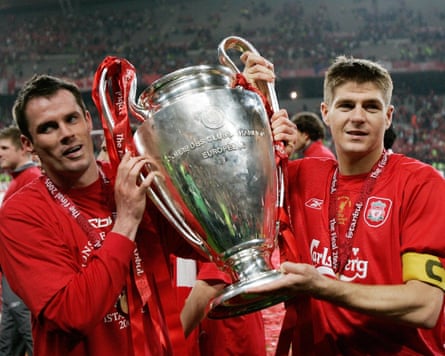
after Liverpool beat AC Milan on penalties in Istanbul in 2005. Photograph: Daily Mail/Rex/Shutterstock
Family and football were indivisible throughout Carragher’s childhood. As soon as he was a toddler, he’d join his dad on the touchline for amateur matches. In his autobiography, Carragher recalls being transfixed, “not only by the football but by the whole culture that accompanied it: the togetherness, the banter, the aggression, the celebrations in victory, the despair and conflict in defeat. I was eased into this world, then locked into it.” At home, as he grew older, he’d linger feverishly over copies of Shoot magazine, while wearing out his VHS tapes of famous Everton victories on Match of the Day, replaying and imitating them until he’d savoured every cadence. “Gray’s there again – oh, I say!” he’d repeat, doing his finest John Motson impression, in honour of Everton’s Andy Gray: the man he would later replace at Sky.
Carragher’s obsession with the game was matched by a hyper-competitive streak on the pitch, as he realised the power that his enthusiasm could have against players less radically committed to football than he was. (“For me, winning was all that mattered,” he told an interviewer not long ago. “When I played, I’d rather cheat and win than not win.”) From the age of seven, he barged his way into leagues full of players older than him, gaining a reputation as a prolific, pugnacious goalscorer. He found his way on to the radar of Liverpool’s School of Excellence, and even there, his attitude couldn’t be quelled, proudly wearing his Everton kit to training.
He made his full Liverpool debut in January 1997 and, a few weeks later, he got his first Premier League start at Anfield. In those early days of his career, he still harboured a secret affection for his boyhood team. One persistent local rumour was that his trademark long sleeves were an effort to conceal an Everton tattoo. (“It doesn’t exist,” he writes in Carra. The reason, he explained, “is because I think I’ve got skinny arms.”) The moment he turned his back on the Blues came in a pub just off Marsh Lane, on 24 January 1999. Stopping into his staunchly Evertonian pub for a consolation drink after a bruising loss to Manchester United, Carragher found himself being treated “like any other ‘dirty’ Kopite”, he writes. At that, he rejected his former allegiances once and for all, as did his family.
As a young player, his relationship with the media was not straightforward. In December 1998, Carragher, aged 20, made the cover of the News of the World, pictured at Liverpool’s Christmas party in the city centre, surrounded by strippers, dressed as Quasimodo and covered in whipped cream. It was a useful lesson on the nature of the tabloid press and the exposure that comes with celebrity – but instead of shying away from the media, as many young pros do, Carragher went in the opposite direction. “I loved getting interviewed,” he told me. “I used to look forward to them. I’d probably do two or three big interviews a season, because I loved talking about football.” He relished the chance to shape his own narrative. “When you’re a player, you can’t say what you think. You’ve always got to say what the club wants you to say. But in a big sit-down interview, you could get a few things off your chest – your thoughts on the game.” Even back then, Carragher’s football knowledge was formidable. “He’s not a thick scouser from Bootle,” wrote Steven Gerrard in his autobiography. “Get Carra on past or present players, and he’ll rattle off their goal record, club history, strengths, weaknesses, birthplace and probably even their star sign and favourite holiday destination.”
The pinnacle of his playing career came against AC Milan in the 2005 Champions League final. That night he put his encyclopedic football knowledge to good use. The game came down to a penalty shootout, and Carragher advised goalkeeper Jerzy Dudek to wiggle his arms and legs frantically in the shootout, in homage to Bruce Grobbelaar in Liverpool’s last successful European Cup effort two decades prior. Dudek’s antics succeeded, Milan fluffed their lines, and Carragher’s side stole perhaps the most famous victory in the competition’s history, having come back from 3-0 down. “I noticed the difference before and after we won,” Carragher told me. “I became one of the players that people wanted to speak to.”
For eight more seasons, he served as bedrock and vice-captain for the Liverpool side, a dependable figure in a sometimes dismal era, before calling time on his playing career in 2013. He was hoping he might become part of the coaching staff, but it didn’t work out. The summer before his retirement, he made his on-screen debut for ITV’s pundit panel during Euro 2012. He’d enjoyed himself, and producers had taken notice. “I started to get people asking the question, ‘Do you want to be a pundit?’ And in the back of my mind I thought, ‘Yeah, I’d love that.’”
Ever since the inception of the Premier League in 1992, Monday Night Football has been one of the foundations of Sky’s coverage. The modern era of MNF began in 2011, when the recently retired Manchester United captain, Gary Neville, began his stint on the show. “People talk about him changing punditry, and he did,” Carragher told me, as we sat in the catacombs of the Sky Sports compound in a brief moment between production meeting and rehearsal. “He was absolutely amazing.”
Neville lifted the lid on the kind of video analysis used at the highest level of the game. “He looked at how Stoke were defending set pieces in zonal marking,” says Gary Hughes, Sky Sports’ director of football. “No one ever talked about how a team presses before.” That may be something of an exaggeration, but the broad strokes are true. Within 18 months, Neville took the show from a relic of the old era to a symbol of the new: younger, more combative and social media-friendly. His squealing “oohhOOOOOhhhhhhh” – quickly dubbed the “goalgasm” – in response to a late Chelsea goal against Barcelona was an early viral sensation.
In 2013, as Neville was making a name for himself as a pundit for Sky, Carragher was starting to attract interest from rival TV operations. Neville told me: “I got a call from our producer, Scott Melvin, who said that Jamie Carragher is speaking to another channel.” He was – and it was Sky’s biggest challenger in a decade, BT Sport, who had spent millions on securing 18 big fixtures for the forthcoming season. BT wanted their own lead analyst to challenge Sky’s grip on Premier League coverage. Carragher told Sky that only one thing could tempt him to turn down BT: a spot alongside Neville on Monday Night Football. “I could have finished Carragher’s punditry career at that point, if I’d said no,” Neville told me, in a tone that didn’t sound like joking. “But actually, I said: ‘No, I think it’s the right moment to change.’” Carragher announced his Sky deal in the days prior to his retirement, and a miniaturised SkyPad was promptly shipped to his house so he could learn how to master the show’s famous “tactics table”.
And so began one of the most compelling double-acts in British broadcasting history: two men who, on the pitch, had embodied their rival clubs and their cities on a spiritual level, now working side by side. Carragher arrived to a show that was thoroughly Neville’s domain: he had to deal with the perception of simply being the “mouth” of the show, where Neville was the “brain”, the better analyst. He also had to learn the mechanics of live broadcasting. On his first episode the touch screen froze for “what felt like 10 seconds, but was probably two”, he recalled. “I froze, and someone in my earpiece says to try again. I say ‘Oh, OK’ – but I say it out loud, on air, to no one.” For weeks after, the crew would greet Jamie with “Oh, OK” at every opportunity.
In those early episodes, Carragher and Neville looked somewhat stiff and awkward in their oversized suits, but things sparked to life when they started bickering. As they grew more comfortable on camera, they turned arguing over football into a fine art. A typical row would feature any, if not all, of the following: Neville’s smirking and raising his eyebrows as Carragher laboured a point; Carragher’s judicious use of “Gary Neville” in the third person (Turns to camera: “What is Gary Neville on about?”); Neville issuing a cutting, patronising “James” to bring Carragher back to heel; Carragher’s dismissals growing more fervent as the TV voice fell away and he sped up to natural pace, attacking the point in full scouse flow, thrusting his body forward and back with every rebuttal, as if he was about to punch Neville. And then Carragher’s laugh, cannily deployed to defuse the situation or to further the insult.
Even more than most pundits, the duo became symbols: Neville something like the representative of English football’s establishment – Manchester United, the FA, the referees, the managers, the rules – Carragher more like the puckish spirit of the sport: a diehard fan who just happens to have been a player. The pair’s clashes, over VAR or changes in the offside rule, felt real and existential, which made their points of consensus – like on the short-lived proposal of the European Super League, decried by the pair for a whole episode of Monday Night Football – seem more of an occasion.
As Twitter reached its imperial pomp in the mid-2010s, Carragher and Neville became fully developed cross-platform characters, skewering each other on screen and online as often as they could. Sky Sports relished clipping this up for digital consumption, and devising new scenarios to wring every last bit of monetisable content from their two leading men. There are compilations of their most competitive moments: everything from indoor cricket to stag-do-style zorbing, step-climbing, present-wrapping, shuttle sprints, darts, trivia. Taken as a viewing experience, they feel less like punditry and more like sketch comedy.
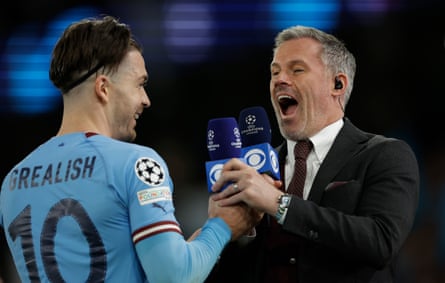
These moments are the progenitors of strange new developments in football broadcasting. Take The Overlap on Tour, Sky’s picaresque travelogue series where Carragher, Neville and Roy Keane roll through the continent, kissing the Blarney Stone or zip-lining through the mountains of Abruzzo. We are a long way from a bunch of ex-pros watching a game and sharing opinions on it. Neville’s roundtable podcast, Stick to Football, is weirder still: the venue is somewhere between a hotel breakfast buffet and the dream room from Twin Peaks, where every Premier League legend is inexplicably hanging out and making small talk with one another, over croissants and bottles of Huel. This universe of football-adjacent content, where former players chit-chat with the easy candour of dads around a barbecue, seems designed to remind you that your idols are not gods, just largely unremarkable middle-aged men who watch the same sport you do.
Sky has offered versions of this for years – take Soccer AM, for instance – and the broadcaster didn’t invent comic football entertainment. But Carragher and Neville were the line in the sand between the pundits of old and the new wave, as they became characters that lived on your screen, on your feed, in your ears and in your head once the show was over – figures that now lived in the imaginations of every fan, not just their own club’s. “When I was a player, what I said probably wouldn’t have affected Arsenal supporters or Tottenham or Aston Villa,” Carragher told me. “But now, because you speak about everybody’s team, everyone feels they have ownership of you.” More platforms, and greater exposure, meant that fans, players and pundits could all duke points out in real time, all part of the same ceaseless flow of discourse.
As a pundit, Carragher cultivated a reputation for giving back to all comers, a tendency that, in March 2018, nearly cost him his job. After a Liverpool defeat, he was driving down the famous East Lancs – the A-road connecting Liverpool and Manchester, whether they want it to or not – when another driver spotted him and started to goad him, filming him from an open window while chanting “2-1! Unlucky, lad! 2-1!” Suddenly, as the video of the incident mortifyingly shows, Carragher volleyed a mouthful of water toward the car, catching the opposing driver’s teenage daughter in the crossfire. A swift suspension by Sky, a full apology and a brutal Sky News interview allowed him, eventually, to return. He rejoined the Sky Sports team the following season.
It was around this time that Neville began to pull away from Monday Night Football. “I’d done it for six years, and you can only talk about right backs and left backs, or left- and right-wingers, so many times,” he told me. He reduced his commitments, suggesting that different guests step in to take his place – an early iteration of the form that the show takes today. By the end of last season, Neville said that he had “got to the point where I thought, ‘This isn’t for me any more. I’ve done this. I’ve done everything I can.’” And with that, the era of Jamie and Gary – which helped define the coverage of the modern game – came to a quiet close. (“I still do the first one of the season,” Neville said with a smile, “because they like to get our predictions, so they can see how badly we’ve done at the end.”)
Now steering solo, Carragher is determined that his Monday Night Football stays on the bleeding edge of football discourse. “You can never stand still,” he told me. “I never want to be someone who keeps talking about ‘in my day’. What are the managers doing now? What are the modern things they’re looking at? What are the training techniques? What are the stats we’re looking at? That’s what I want us to be.”
If Monday Night Football Carragher is the football nerd, then the Carragher who appears on US TV is a different proposition: looser, more relaxed, as befits a show where the aim is less to impart information than to build a connection with the hosts.
The origins of the CBS Champions League show go back to the summer of 2020 when, in the midst of the first lockdown, Pete Radovich arrived in London from New York. Radovich, decorated producer of Inside the NFL, had only six weeks to find a studio, staff and talent, in time for the launch of Paramount’s new Champions League show on CBS. “I made a few phone calls to people I knew in London, and just asked, ‘Hey, if you were me, who would you start with?’ Every single person said: ‘Gary Neville.’ Every single person.”
Negotiations with Neville, however, soon ran aground. “We were apart on money,” said Radovich. “We were apart on workload.” As they mulled alternatives, Radovich started paying more attention to Neville’s Monday Night Football co-host, Carragher. “I saw him and thought, ‘He’s our Phil Simms.’” Simms, as Radovich helpfully explained, was Inside the NFL’s Mr Versatile: able to switch between breaking down plays and bringing down the house with one-liners. He saw the same in the argumentative, analytical Carragher, but had one nagging fear – his accent.
“One of my very first questions, if not first, was: ‘Hey, can you dial back the scouse? Is that a thing that you can do?’” Radovich recalled. “And he said, ‘Absolutely.’” (Carragher concedes the existence of his TV voice, although does so in a robustly scouse way: “Me family says I have, yeah. It’s natural when you’re on TV.”) Radovich loves to tell the story of the test that earned Carragher his spot on the CBS panel. The network’s three executives took recordings of Jamie’s voice back to their wives, and if they deemed him to be intelligible, the job was his. “He won by a vote of two to one, and that was the deciding factor, I shit you not,” said Radovich.
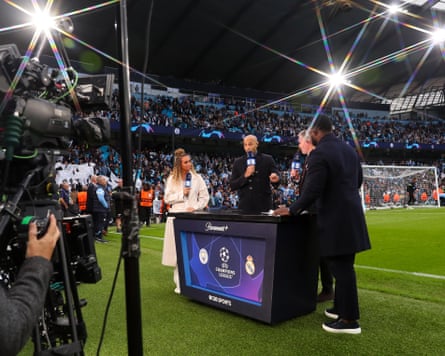
Carragher joined his new colleagues at Stockley Park, a stone’s throw from the Premier League’s VAR control room. Alongside him were Ballon d’Or host Kate Scott and Micah Richards in the studio, and roving reporter Peter Schmeichel in the field. Radovich cites the show’s first production meeting as the model for the show itself. “I get there, and Jamie’s already giving Peter Schmeichel some stick, Peter’s giving Jamie stick. Forty-five minutes go by until Kate asks, ‘Should we start to plan the show?’, and it hit me: this should be the show.” “It’s really like a family,” as Thierry Henry, who joined the team later, likes to summarise it. “I’m more serious, you have Micah’s laughs, Jamie’s spikiness and Kate’s the big sister who keeps us in check.”
If you’ve seen them on-screen in the UK, it’s most likely you’ve seen them clipped up into YouTube summaries or TikTok highlights: a blessing and a curse for UCL Today, which enjoys huge numbers on social media, along with a reputation – to the producers’ slight chagrin – for being light on analysis. “I’ve been watching coverage of the sport in America my whole life,” Radovich told me. “It was all over the map. ‘This is why X player is like LeBron James’, ‘This is the offside rule’. When we took it over, we decided we were going high-level, to make coverage that could play in Europe and nobody would be offended.” The show’s analysis, for the American audience that gets to see it, is excellent. It is little more than a quirk of European sports rights as to why we can’t see Henry and Carragher dissecting Lamine Yamal’s body positioning, or the way Denzel Dumfries strikes a dead ball. Those images belong to another broadcaster, packaged in a different deal, meaning that only viewers in the US can see them. CBS navigates this by showcasing all of the bits that make UCL Today format-breaking, without the substance that grounds it in conventional sports broadcasting.
Leading that effort is Carragher. “He’s good at giving you high-level analysis, but he can make it understandable to me, who’s never played the game,” says Kate Scott. Radovich, who has worked with Super Bowl winners and broadcasting legends, agrees. “You can count on one hand the pundits who have figured out the analysis side of the job and the entertainment side of the job,” he says. “Jamie gets it. When I asked everyone: ‘Who should I speak to first?’ Five years ago, the answer was Gary Neville. We’ve come to a point where if I made that same call today, it might be a different answer.”
Saliba can’t play without Gabriel. Marc Cucurella has been a different player this season. Myles Lewis-Skelly is incredible. Nottingham Forest’s push for Europe wasn’t a fluke. Szoboszlai’s energy is vitally important to Liverpool. Liam Delap shouldn’t move to Manchester United; Matheus Cunha should. These are, at the time of print, Carragher’s last seven publicly stated opinions, expressed on the final Monday Night Football of the season; chopped up into a trio of YouTube clips, already tipping a million views; quoted in 34 articles at the time of press, from the Daily Mail to the Shields Gazette. By the time you read this, there’ll be more: more quotes, further takes, still more opinions about Carragher’s opinions.
The constant static of the discourse isn’t quite so deafening on Marsh Lane. When he was finished with his vegetable soup back at the Brunswick, Carragher invited me out for a short tour of the universe: The Salisbury, Philly’s old pub; Dong Sing’s, “the chippy” – which in Liverpool, often means a Chinese takeaway; the family church, St James’, known locally as “Bootle Cathedral”; and the 20-foot mural of the two Carraghers: young, blue and Bootle’s own; old, red and Liverpool’s. As we walked, old ladies stopped him in the street. He seemed to know them all – he either went to school with their sons or played football with them somewhere along the way.
Before I left, Carragher recommended I seek out his very first interview, a snapshot from the dank, heady fug of teenage victory over West Ham in the 1996 FA Youth Cup final. Aged just 16, in a dressing room full of raucous young players enjoying their first real taste of silverware, Carragher is remarkably calm. His haircut is the same as it is today. His mouth dictates the motion of his whole face, as it still does to this day. His accent is squeakier, sharper on the ear, yet to be smoothed out by media training. YouTube’s auto-translate assumes he’s speaking Polish. Despite the revelry in the background, he’s blunt and to the point: “Thought we played well, bit of a bad stAAArt” – his voice cracks, before he responds to some rapid-fire follow-ups. “What score was it at the end? 2-1? 3-1? Probably should’ve scored more …”
Some might remark upon his transformation from the shouty, puce-faced visage of unbridled emotion that he seemed through the height of his playing days, to the cerebral pundit and consummate broadcaster he has emerged as 30 years later – but to do so would be to suggest a change that, by all accounts, hasn’t taken place. “That’s how I am,” he told me of that first interview. “That’s me as a football fan, that was me as a player, that’s me as a person.”
I took a final walk, alone, through Bootle, back towards the station and into the centre of town when my phone buzzed in my pocket. It was Philly, calling to ask how the day went.

 4 hours ago
3
4 hours ago
3
